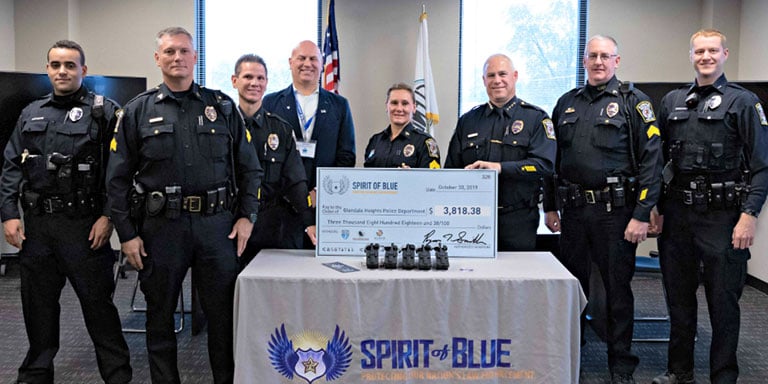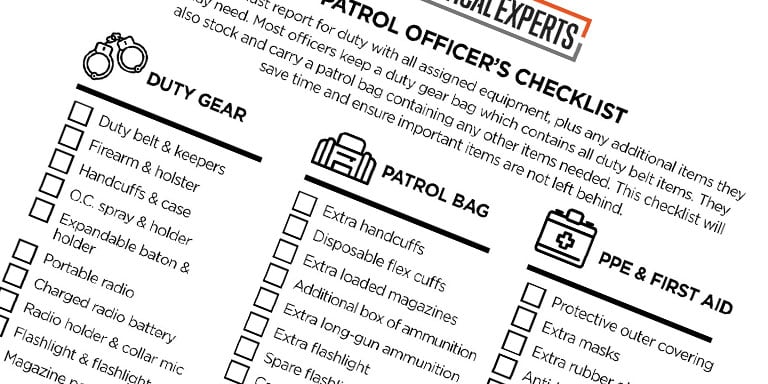CommandCentral Evidence - digital evidence management software
These grants usually come from foundations and private companies. They are limited and generally smaller, but can be a source of acquiring needed equipment.
COPSOne successful federal grant program is Community Oriented Policing Services, known simply as the COPS grants. These grants pay up to 75% of newly hired community policing officers' salaries for up to three years. They allow departments to expand their departmental workforce to include officers implementing a community policing strategy. In 2020, the COPS grants total was nearly 400 million dollars, intended to pay for the hiring of 2,732 police officers in 596 law enforcement agencies.
To locate a particular states' grant announcements, go to that state's website and look for a grants page. Every state is different, so if a separate page does not exist for grant applications, then locate it in the search window. Enter the words “grant” or “police grants” into the search bar. This should provide information on all available state-funded grants and how to apply.
Each state legislature will set up grant programs to address their own set of priorities. Some federal grants are distributed to state agencies that award individual grants to specific departments within their state; an excellent example of this is the money provided by the Federal Highway Traffic Safety Administration. These monies are used to address drunk driving, seatbelt usage, aggressive driving and, more recently, cell phone usage behind the wheel (in states where it is illegal).
Most grants have their own dedicated web page with a detailed description of the grant, an on-line registration page and the application. Read the description of the offering closely and determine if the grant will address a severe departmental need. Programs usually list the total amount of money available in the grant and the maximum amount awarded to any recipient. Also, take note of the filing deadline and specific allowed uses for the funds. Most grant funds come with many strings attached regarding how the money can be used; for example, some grants are only open to departments of a specific size or population density. Take note of any qualifiers and limitations in the description.

The remaining submissions will be scored on a preset number of criteria. These might include the severity and immediacy of the need, the lack of other funding based on a jurisdiction's financial condition, the clarity of the mission stated in the proposal or the probability of success.
Each grant proposal is a unique document that expresses a specific problem and solution, connecting all the dots in between. No two grant proposals should look alike. The grant reviewer should easily be able to identify that the writer specifically addressed the particular grant's objectives and aligned them with the proposal's goals.
While grants can solve many departments' fiscal issues, they don't just magically appear. The process of researching grants, writing proposals and submitting those proposals is potentially long and tedious. With the right method and know-how, though, it's something you can do that will greatly help your department in a number of ways.
The person responsible for grant writing should be well organized, detail-oriented and have above average report writing ability. Probably the most important attribute, though, is the desire to learn (though a bit of a competitive streak doesn't hurt, either).
Careful accounting will have to be maintained for years on every penny that is spent. These records are subject to government audit and investigation. Documentation with receipts or purchase orders should be kept in a separate grant file or binder. These materials should be well organized and kept together to be easily accessible, even on the grant administrator's day off.
Writing a grant proposal is a competition. The writer's work will be judged against the work of professional grant writers hired by large city departments. What a police officer may lack in the finer points of grammar, though, are more than made up for in their understanding of police work. Knowing what works and what won't, based on years of experience and citizen interactions, is invaluable. Not every proposal will be accepted; only a small percentage of proposals for some competitive grants will succeed. But the first time you find success, it will bring a sense of accomplishment you won't soon forget.
Continued funding will identify how the program will continue to be funded after the grant money is gone. The grant's objective is to effect lasting change, not fund short-term results that will revert back as soon as the grant money is depleted. Identifying where future funds will come from to maintain the program is always necessary.
Byrne Justice Assistance GrantAnother essential federal grant open to virtually every department is the Byrne Justice Assistance grant. This ongoing grant provides needed financial resources to police departments on a continuing basis. During 2019, nearly 264 million dollars was made available for this grant.
The grant proposal must state clearly that a need exists and can be addressed by the funding the grant provides. This need must not only be identified, but also backed up by data demonstrating the need. This is also the area in which to discuss other solutions that may have been attempted and why those attempts were unsuccessful. It is helpful to show where a program or equipment might solve multiple problems, adding additional value.
It appears your browser does not have cookies enabled. In order to check out, enable browser cookies and refresh the page.
The announcement of Taser's latest device comes amid calls from San Francisco Police Chief Greg Suhr and the Police Officer's Association to equip officers with stun guns after officers fatally shot Mario Woods in December.
Other Federal Agency GrantsWhile the Justice Department administers most federal police grants, there are many federal departments and agencies with grant money available for specific law enforcement purposes. Even the Department of Agriculture has a law enforcement grant program. The Rural Development Community Facility Grant Program allows towns with less than five thousand residents to apply for funds to build new police stations or, in some cases, buy new police cars.
The outcome documents how the program implementation can lead to a positive result, and should be explained in readable metrics. Take this example:

Private companies are an excellent resource for help with grant writing. One of the most sought-after upgrades is money to purchase body-worn camera systems. These cameras are being considered by most police departments nationwide, and you can read more about them in our officer's guide to police body cameras. They are quite expensive, though, and require large leased or owned storage space for their massive video data files. As a result of their price tag, body camera systems are a well-targeted use of grant money.
It appears your browser does not have javascript enabled. In order to check out, enable browser javascript and refresh the page.
Now it must be decided who will administer the grant. Almost every grant has a long list of how money can and cannot be used. These rules must be strictly followed. One person in the department will act as the grant administrator and be held accountable for the proper use of funds. Additionally, many grants require officers to complete progress and keep statistics identifying whether or not the grant money is achieving the expected result, as documented in the proposal. This is particularly important for multi-year funded grants.
Two of the largest manufacturers of police body cameras, Watchguard and Axon, have extensive information about grant writing on their websites. They offer expert assistance and grant writing guides with actual grant proposals for camera systems. These companies aren't in the business of grant writing, but rather the business of selling camera systems. It's in their best interest for body-worn cameras to receive grant funding. Free professional assistance is always welcome, so this is a good starting point for body-worn camera grants.
The art and science of de-escalation will take time, training and practice to master. Read up on applicable skills here.
One of the best sources for learning grant writing's unique language is to read other successful grant proposals. These can be located with a couple of searches on the web. There are also tutorials available through government websites and even online grant writing courses. Many police academies offer a catalog of continuing educational courses for police officers, including writing grant proposals.
There are often many different approaches to solving a problem or deficiency. The grant writer's job is to identify the best approach to solving the problem using facts and data to re-enforce it. Show why this approach has the most significant potential for success in solving the problem.
Too much is not better. Providing more than what the directions require can lower the proposal's score or cause it to be rejected. The safest route is to follow the grant application rules exactly.
(CBS SF) – Taser International has released their smallest stun gun ever, marketing the devices for private citizens even as San Francisco as officials debate whether or not police officers should carry their own stun guns.
There are many funding sources available to police departments across the country. Each source comes with its own strings attached and methods by which to receive those funds. The main three sources are federal money, state money and private grants.
The lion's share of police grant money comes from the federal government. Congressional legislators decide what priorities need to be addressed in police departments and set aside large quantities of grant money that departments must apply to receive. Some federal grants will support almost all that apply, while many others are highly selective and competitive.
The department has requested Tasers multiple times in recent years, but has been met with resistance from advocates who say the devices are too dangerous and used often unnecessarily.
When the proposal is complete, have someone outside of the process (and outside of police work) read it for content and grammar. If it doesn't make sense to them, it might not be clear to the grant reviewer, either. Make corrections until it reads easily and is clearly understandable by any audience.
In a job where every second makes a difference, you need to be sure your police duty belt is set up for maximum efficiency.
Grant money is available to police departments who successfully complete the grant application process. To understand grants, it is important to understand the purpose they serve. First, money is allocated to address specific needs within police departments. These needs may be broad, such as providing money for additional officers through the COPS grant program. They can also be relatively narrow and specific, such as providing money for police training in de-escalation techniques or methods of investigating domestic violence. Other grants may address particular equipment needs, such as implementing a body-camera program or even a drone program.
Grants are highly competitive. Only the best written proposals that are directly on point stand any shot at scoring high enough for consideration. Make sure the grant description matches the equipment or program philosophy being proposed. It's a waste of time to stretch a grant's boundaries to fit your proposed program. For example, one shouldn't seek to buy SWAT team equipment using community policing money.

The company said the device has a 15 foot range and has a high voltage output of 30 seconds, allowing the user time to make an escape. Unlike versions sold to police, the Taser Pulse doesn't include data logs.
"This high-tech, easy-to-use weapon is built for concealed carry but packs the same knock-down punch that has become the standard for law enforcement around the world," Rick Smith, the company's CEO and founder said in a statement.
The department had one hundred citizen complaints this year. With the body-camera program fully implemented, we expect to reduce that number by thirty percent over the first twelve months.
One of the first steps in receiving grant money is finding the grants themselves. Each grant does things a little differently, so we'll tell you where to look based on your needs.
Reviewers may consider thousands of proposals for only a small number of grants. A good rule is that the greater the amount of dollars involved, the more applicants will apply. With so many proposals to consider, reviewers usually score them numerically. In competitive grants, any proposal that fails to follow a single instruction or doesn't provide something that's asked for will usually be rejected.
The internet is key to the search for grants. The starting point for federal police grants is the U.S. Department of Justice's website. It will take time and exploration of the many links this massive site provides to get started on the application path. There is much to read and learn on this site, so do your due diligence.
Outcomes are particularly important for grants that run for more than a single year. Continued funding of a new or pilot program will be dependent on showing proof that the program is working. A program that doesn't hit expected outcomes may be defunded.
Using the example of body-worn cameras, the primary goal may be to increase police accountability and transparency. However, secondary goals might include:
Measuring 5 ¼ inches long, 4 ½ inches tall and 1 1/8 inches wide, the Taser Pulse is expected to begin shipping sometime in the first quarter of 2016.
Once a grant opportunity has been identified that matches a specific area of need in the department, it's time to do the research. All grant proposals are separated into four areas that must be addressed: need, approach, outcome, and continued funding. Each area must be thoroughly addressed, making a strong case for why this particular department's need is worthy of grant funding.




 Ms.Cici
Ms.Cici 
 8618319014500
8618319014500